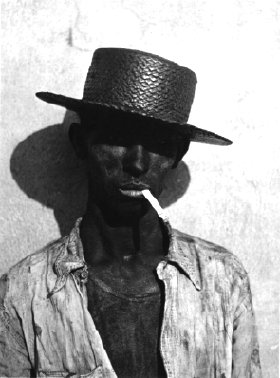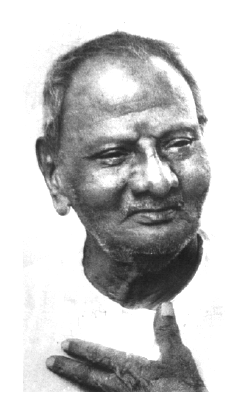Heart
The Power of Photography:
A Collector's Choice
Adam D. Weinberg
(Aperture)
 This is a collection of some seventy photographs by as many different photographers. Some are as early and as famous as Man Ray, Edward Weston, Walker Evans, or Jacques-Henri Lartigue; some are as recent as Sally Mann or Jack Pierson (who writes "most days I thiNK I'D RATher be a PHOTograPH than a huMAN Being.")
This is a collection of some seventy photographs by as many different photographers. Some are as early and as famous as Man Ray, Edward Weston, Walker Evans, or Jacques-Henri Lartigue; some are as recent as Sally Mann or Jack Pierson (who writes "most days I thiNK I'D RATher be a PHOTograPH than a huMAN Being.")The volume consists of a hundred or so words about the photographers, along with direct quotes from them. For instance, W. Eugene Smith, the great wartime photographer says,
- World War II...and each time I pressed the shutter release it was a shouted condemnation hurtled with the hope that the pictures might survive through the years, with the hope that they might echo through the minds of men in the future --- causing them caution and remembrance and realization.
And the late Francesca Woodman, quoting from Italo Calvino:
- It is my image that a I want to multiply, but not out of narcissism or megalomania, as could all too easily be believed: on the contrary, I want to conceal in the midst of so many illusory ghosts of myself, the true me, who makes them move.
 The question of this or any other book of photographs is, "Is it worth it?" And we would say yes, not only because the price is a relatively reasonable $29.95, but with the understanding that once you buy the book, you can become a collector too, like Sondra Gilman: what you do is immediately set to work with razor blade, and cut out your favorites, and hang them in the bathroom or on the door of the refrigerator or in the windows of your apartment or even on the telephone poles in the neighborhood so other people can love them too. I mean, what a waste it would be to have such fine representations of our world sitting closed up there in the bookshelf.
The question of this or any other book of photographs is, "Is it worth it?" And we would say yes, not only because the price is a relatively reasonable $29.95, but with the understanding that once you buy the book, you can become a collector too, like Sondra Gilman: what you do is immediately set to work with razor blade, and cut out your favorites, and hang them in the bathroom or on the door of the refrigerator or in the windows of your apartment or even on the telephone poles in the neighborhood so other people can love them too. I mean, what a waste it would be to have such fine representations of our world sitting closed up there in the bookshelf.
Aperture --- the folks who make this book (and hundreds like it) possible deserves your love and support. They work as a non-profit organization, and you can and should subscribe to their magazine, or at least get on their mailing list. They're at Box 3000, Denville N.J. 07834.
and is entitled "Puerto Rican Woman (1965)
© 1969 The Estate of Diane Arbus.
"Havana Dock Worker" (1932) is by Walker Evans
© Walker Evans Archive, the Metropolitan Museum of Art.
Way of
Awakening
An Essential View
of Religion
Swami Kriyananda
(J. Donald Walters)
(Crystal Clarity)
Pierre Verger spent forty years studying and photographing the candomblé religion. When they asked him, after all those years, if he could understand it, he replied:
- Alas, I am too rational. Reason. It kills everything. All chance for pleasure, for relaxation, for real sentiment.
We were put in mind of this as we worked our way through The Hindu Way of Awakening. The author goes by the name of Swami Kriyananda. He is one of Yogananda's followers, which is, presumably, where he got the handle "Swami." In truth, he is J. Donald Walters. And he writes, early on in this book,
- The rain, Paramhansa Yogananda said, is a message to us of Divine Compassion; the flowers whisper to us of God's love and joy; the tenderness of Mother Nature reminds us of the consciousness in which She wants us always to live...
Well, this may well be so, but if this is Yogananda's message, somewhere it got lost on Walters. In the midst of his telling us of the love and compassion of Hinduism, he erupts in strange frenzies of apoplexy.
- Friedrich Nietsche would have been a good example of a false prophet, had anyone thought to accord him the dignity of prophet in the first place. His book, Thus Spake Zarathustra has some of the ring of authentic scripture, at least in its portentous self-assurance...[but] it soon betrays itself as lacking in the one essential ingredient of all scripture: consistency with the oft-stated truths of the ages. It is rather, the raving of an ego-maniac whose life ended in madness because his human brain was not equal to the strain of his presumption.
Whew! Thus, so glibly, and easily, we kiss off one of the master philosophers of all time, the father of Existentialism, of psychoanalysis, and an astonishing number of modern philosophical concepts.
One of the messages of Nietsche --- often perverted by those who don't bother to read him --- is that we have to find the power of survival within ourselves. The gods are not going to save us; it's all up to us. If one looks into the essence of Hinduism described by The Mahabharata, the message is about the same: you can look everywhere for the power of the divine, but, in truth, it is within. If we can but shut up the babbling mind, we'll find it. As the Lama Yeshe says, "To succeed in tantric practice it is essential to identify yourself strongly as a deity..." which is, as we read it, pure Nietsche.
Swami Walters' problem, we do believe, lies in that picky Western rationalism underlying his fancy-dan garb of neo-Hinduism, and it turns him cynical and belligerent:
- The real contrast between genius and stupidity lies not in skull capacity, but in mental energy. High mental energy is always the mark of genius. Stupid people, on the other hand, always display low mental energy.
Somehow, the idea of a Swami classifying people as "genius" or "stupid" --- a Western dualism if there ever was one --- doesn't fit with our understanding of Hinduism, a religion built on tolerating multiple gods with crossing, often contradictory, powers.
Besides his facile cynicism, Walters revels in misstatements of fact. Nietsche didn't go mad because of "the strain of his presumption" --- he was suffering from the AIDS of the 19th Century, tertiary syphilis. Further, in what Walt Kelly once called "the confidence of ignorance," Walters tells us:
- It was only in the early Eighteenth Century, at the beginning of Dwapara Yuga, that Bishop George Berkeley of Ireland proposed the unheard of concept that everything exists only in thought. To this "notion" even Samuel Johnson, brilliant man though he was, responded by giving his faithful biographer Boswell a kick in the seat of his pants, then demanding, "Was that kick, Boswell, only a thought in your mind."
Good try, Walters. But Johnson, if we are to trust Boswell (and it might be wise to do so), merely kicked a door, not Boswell's bottom.
If Swami Walters were merely cantankerous, we could warm to him easily.  After all, the words of the great Hindu master, Sri Nisargadatta Maharaj are often sarcastic jeerings, biting comments on his questioner's presumed spiritual quest. But underlying these jeers is a passionate commitment to the necessary task of discovering the "inner watcher." ("It is the task of the watcher to understand and thereby eliminate the person," said Nisargadatta.) Would that Walters could eliminate this person in him, the one that confuses the watcher and the watched, classifies people as "stupid" or "smart," and gives us a very Cartesian black-and-white either/or.
After all, the words of the great Hindu master, Sri Nisargadatta Maharaj are often sarcastic jeerings, biting comments on his questioner's presumed spiritual quest. But underlying these jeers is a passionate commitment to the necessary task of discovering the "inner watcher." ("It is the task of the watcher to understand and thereby eliminate the person," said Nisargadatta.) Would that Walters could eliminate this person in him, the one that confuses the watcher and the watched, classifies people as "stupid" or "smart," and gives us a very Cartesian black-and-white either/or.
One critic has said the problem with Nietsche was that instead of writing "Either/Or" he should have written "Either/And/Or." In that way, he would have been well on the way to understanding the more tolerant eastern religions that might have made his lonely seeking more tolerable, less cruel.
Be that as it may, a man who could write of himself, "Some people are born posthumously," certainly deserves more respect that to be mocked as nothing more than an "ego-maniac."
Think Like
A Millionaire
Mark Fisher and
Marc Allen
(New World Library)
Do we really want to think like a millionaire? If so, which one?
- J. P. Morgan?
- John D. Rockefeller?
- Henry Ford?
- Donald Trump?
- H. Ross Perot?
- The guys running Pacific Lumber, chopping down all our redwoods?
- The guys who just built those repulsive townhouses up on the hill where I used to run and play and lie under the stars in the fields at night?
- The guys who own Cox Cable and jack up the fees, what the traffic will bear, every two or three months?
- The guys who own Fox Television, giving our children (and our children's children) between fifty and sixty bloody, graphic, in full-color murders a week?
- Snoop Doggy Dogg?
Speaking of Snoop Doggy Dogg, our friend Charlie Krafft has been invited to show his Disasterware® --- Delftware plates with portrayals of the likes of the Hurricane of 1928, the explosion of the Hindenburg, the sinking of the Andrea Doria --- at Slovenia's Ministry of Defense, Department of Protocol in Oct. 1999 in Ljubljana. It is to be entitled "The Porcelain War Museum Project."
They are going to provide an army band. Charlie is to select the music. He wants someone to transcribe Mr. Dogg's music for coronet, trumpet, trombone, and tuba. One song he's especially fond of goes,
- Snoop Doggy, Do-owww-ohhhh-oggg (the bomb)
Snoop Doggy, Do-owww-ohhhh-oggg
Da-duh-da-da-dah
Do-do-do-do, doo-doo-doo-da-dahhh! (the bomb)...
Bowwowwowyippyyoyippyyay,
bowwowwowyippyyo (the bomb)
Doggy Dogg, Doggy Dogg, Doggy Dogg
Yeah yeah (Dog) I know his name
C'mon Snoopy, c'mon Snoopy (the bomb)
And the Dogg Pound
Snoopy Dogg (the bomb) Snoopy Dogg
Snoopy Dogg (Dog)
(Dog, nasty dog, doggy dog)
Can you imagine that in the style of John Philip Sousa?